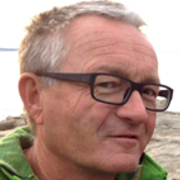
Kim Sinclair
There is a New Zealand angle to most of the screen projects Kim Sinclair has been involved with — whether it be location, subject matter, or the nationality of the director. Yet his photo albums are packed with international locales. Sinclair's busy screen career has encompassed film sets in Mexico, the United States, Thailand (Beyond Borders), Fiji (Cast Away) as well as varied parts of Auckland, the Southern Alps and Taranaki, designing everything from volcanic lairs to Japanese villages.
Sinclair's screen career had an unusual blueprint. Architecture studies at Auckland University behind him, he spent three years growing increasingly uninspired, designing classrooms for the Education Board, before setting off with friend Neil Kirkland to plan and build houses.
It was his partner, future production designer Kirsten Shouler, who found him a film career. Shouler, also architecturally inclined, answered an ad in the Herald for a draughtsman on 1983's Savage Islands, the biggest production to shoot in New Zealand to that date. The film's British design boss was desperate for staff, a desperation that meant jobs not just for Shouler, but also Sinclair and long time righthand man Neil Kirkland. Sinclair worked on Savage Islands for almost a year designing fort towns and bridges across chasms, but never saw a camera once.
Within three movies he had graduated to art director and then production designer. By 1985 Sinclair decided it was best not to take on any architectural work, in case another screen project got in the way. Since then there have been many films and TV shows, from production designing movies Grampire, Alex and the farm-based Black Sheep, to TV comedies Spin Doctors and Serial Killers, to a stint down south as the only Kiwi art director on George Lucas fantasy Willow.
His film resume amply demonstrates the cosmopolitan nature of the business. Savage Islands and Vertical Limit, both key films in terms of upskilling Kiwi design and set-building teams, had multinational cast and crew, but it was New Zealanders in key positions that brought the films down under. Coming of age tale Her Majesty (for which Sinclair won his first film award in 2001) is to all appearances a Kiwi movie — except that it was actually a passion project for American writer/director, Mark Gordon.
Sinclair likes to quote the experience of Vertical Limit to architects who are dismissive of film work as easy, or unimportant. One task for the trio of Kiwi art directors on that film was to design and build a fake cliff more than 30 metres high. Sinclair told industry mag NZ Techo that the finished set was one of the tallest structures in the South Island. "It was very far from putting French braces on the back of a couple of flats, that's for sure". Negating charges that his film sets doesn't last, Sinclair argues that they have lived on in video stores for longer than some of the real world shops and factories he has had a hand in building.
Far off locations have been have been a big feature of the job. When the gigs have been overseas, he has often worked largely with local crews. "I've carved out a career doing difficult locations. I’ve worked in Mexico, and South Pacific Fiji on Cast Away. Legend of Zorro was Mexico. Thailand on Beyond Borders ... Basically looking after art departments in places that are a bit inhospitable. Islands, tops of mountains."
Constructing sets in such locations often means major logistical challenges, including bringing materials in by helicopter. One such case was the Japanese village for The Last Samurai, built in a valley near New Plymouth.
In 2010, Sinclair was one of three art department heads to win both an Oscar and a Bafta for their work on Avatar. The film's production designers Rob Stromberg and Rick Carter worked mainly in Los Angeles, while Sinclair, as Avatar's 'lead supervising art director' and set decorator, was in Wellington readying the physical sets, notably the interiors of the military base on Pandora, and the weapon-packed helicopters. Sinclair argues that Avatar was a key film for the Kiwi industry, in that it marked one of the first times a big-budget production filmed here not for beautiful locations, but for the local knowledge and skill base.
Sinclair followed Avatar with his second film for Jonathan King, a big screen remake of the classic Under the Mountain. "I designed all the key sets, finalised the locations, and built the Wilberforce house when the finance collapsed," says Sinclair. "By the time the movie was refloated two months later I was overseas working on another project, so Ralph Davies was the designer for the shoot."
Sinclair went on to head the design team on The Adventures of Tintin, then was one of the supervising art directors on the North American shoot of Superman reboot Man of Steel. He was production designer of acclaimed local drama The Dark Horse. In 2017 his work on partly Kiwi shot Western Slow West won him Best Production Design at the New Zealand Film Awards.
Sinclair feels confident that increasing use of computer generated imagery won't lead to the demise of the art department. He thinks that for the majority of dramatic stories, having a physical set to work on aids the actor's performance.
Sources include
Kim Sinclair
Kim Sinclair website. Accessed 9 December 2014
'Feature Guest - Kim Sinclair' (Radio Interview) Radio New Zealand National website. Loaded 18 April 2012. Accessed 26 February 2013
Tom Lisowski, 'Kim Sinclair' (Interview). Artstars website. Loaded 26 April 2010 Accessed 26 February 2013
Peter Parnham, 'The Art of Art Direction' (Interview), NZ Techo Issue 45, June/July 2010, Page 4
Diana Wichtel, 'Imaginary architect' (Interview) – Listener, 4 April 2012, Page 30